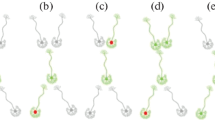Conclusion
These examples demonstrate the usefulness of embryonic neurons for investigation ofneurotropic virus pathogenesis studies. The different steps of viral interactions of neurotropicviruses with the brain necessitate studies of the intrinsic neural properties of the infected cells:1) entry of virus into the intra-cellular compartment, 2) transport of virus from one brainstructure to another brain area, 3) replication of virus in the host-cells, 4) altered brainfunctions. Understanding the mechanisms of neural pathogenesis is a prerequisite for theelaboration of antiviral strategies based upon recovery of the brain from functional alterationsusing drugs active on brain functions.
Similar content being viewed by others
References
CAMPENOT, R.B. (1977). Local control of neurite development by nerve growth factor. Proceedings of the National Academy of Sciences (USA). 74:272–288.
FUKUDA, J. and KURATA, T. (1981). Loss of membrane excitability after herpes simplex virus infection in tissue cultured nerve cells from adult mammals. Brain Res. 211:367–371.
KOSCHEL, K. and HALBACH, M. (1979). Rabies virus infection selectively impairs membrane receptor functions in neuronal model cells. J. Gen. Virol. 42:627–632.
KOSCHEL, K. and MüNZEL, P. (1984). Inhibition of opiate receptor-mediated signal transmission by rabies virus in persistently infected NG-108–15cc mouse neuroblastoma-rat glioma hybrid cells. Proc. Natl. Acad. Sci. U.S.A. 1984. 81:950–954.
LEVALLOIS, C., PETITE, D., TSIANG, H., KAMENKA, J.M., and PRIVAT, A. Phencyclidines and related molecules protect cultured rat cortical neurons against the toxicity of the HIV protein gp 160. Multiple sigma and PCP receptor logands: mechanisms for neuromodulation and neuroprotection? (J.M. Kamenka and E.F. Domino, ed.) NPP Books, Ann Arbor (In press.).
LOCKHART, B. and TSIANG, H. (1991). Actin-dependent maturation of rabies virus in neuronal cultures. J. Gen. Virol. 72:2257–2261.
LOCKHART, B.P., TSIANG, H., CECCALDI, P.E., and GUILLEMER, S. (1991). Ketamine-mediated inhibition of rabies virus infection in vitro and in rat brain. Antiviral.Chem. Chemother. 2:9–15.
LöVE, A., ANDERSSON, T., NORRBY, E., and KRISTENSSON, K. (1987). Mumps virus infection of dissociated rodent spinal ganglia in vitro. Expression and disappearance of viral structural proteins from neurons. J. Gen. Virol. 68:1755–1759.
LYCKE, E., HAMARK, B., JOHANSSON, M., KROTOCHWILL, A., LYCKE, J., and SVENNERHOLM, B. (1988) Herpes virus infection of the human sensory neuron. An electron microscopy study. Arch. Virol. 101:87–104.
LYCKE, E., KRISTENSSON, K., SVENNERHOLM, B., VAHLNE, B., and ZIEGLER, R.J. (1984). Uptake and transport of herpes simplex virus in neurites of rat dorsal root ganglia cells in culture. J. Gen. Virol. 65:55–64.
LYCKE, E. and TSIANG, H. (1987). Rabies virus infection of cultured rat sensory neurons. J. Virol. 61:2733–2741.
MAYER, M.L., JAMES, M.H., RUSSEL, R.J., KELLY, J.S., and PASTERNAK, C.A. (1986). Changes in excitability induced by herpes simplex viruses in rat dorsal root ganglion neurons. J. Neurosci. 6: 392–402.
MüNZEL, P. and KOSCHEL, K. (1981). Rabies virus decreases agonist binding to opiate receptors of mouse neuroblastoma-rat glioma hybrid cells 108-cc-15. Biochem. Biophys. Res. Commun. 10:1241–1250.
OAKES, S.G., PETRY, R.W., ZIEGLER, R.J., and POZOS, R.S. (1981). Electrophysiological changes of HSV-1-infected dorsal root ganglia neurons in culture. J. Neuropath. Exp. Neurol. 40:380–389.
OLDSTONE, M.B.A., HOLMSTEN, J., and WELSH, R.M. (1977). Alterations of acetylcholine enzymes in neuroblastoma cells persistently infected with lymphocytic choriomeningitis virus. J. Cell Physiol. 91:459–472.
STAUFFER, E.K. and ZIEGLER, R.J. (1989). Loss of functional voltage-gated sodium channels in persistent mumps virus-infected PC12 cells. J. Gen. Virol. 70:749–754.
TSIANG, H. (1982). Neuronal impairment in rabies infected rat brain. J. Gen. Virol. 61:277–281.
TSIANG, H. (1989). An in vitro study of rabies virus pathogenesis. Bull. Institut Pasteur, Paris. 83:41–56.
TSIANG, H. (1988). Interactions of rabies virus and host cells. In: Rabies (J.S. Campbell and K.M. Charlton, ed.), Kluwer Acad. Publish. Boston. 988, pp. 67–100.
TSIANG H., CECCALDI, P.E., ERMINE, A., LOCKHART, B.P., and GUILLEMER, S. (1991). Inhibition of rabies virus infection in cultured rat cortical neurons by an NMDA noncompetitive antagonist. MK-801. Antimicrob. Agents Chemoth. 35:572–574.
TSIANG, H., CECCALDI, P.E., and LYCKE, E. (1991). Rabies virus infection and transport in human sensory dorsal root ganglia neurons. J. Gen. Virol. 72:1191–1194.
TSIANG, H., DERER, M., and TAXI, J. 1983. An in vivo and in vitro study of rabies virus infection of the rat superior ganglia. Arch. Virol. 76:231–243.
TSIANG, H., LYCKE, E., CECCALDI, P.E., ERMINE, A., and HIRARDOT, X. 1989. The anterograde transport of rabies virus in rat sensory dorsal root ganglia neurons. J. Gen. Virol. 70:2075–2085.
ZIEGLER, R.J. and HERMAN, R.E. 1980. Peripheral infection in culture of rat sensory neurons by herpes simplex virus. Infection Immun. 28:620–623.
ZIEGLER, R.J. and STAUFFER, E.K. 1987. Mumps virus-induced alterations in cellular excitability during persistent infections. J. Gen. Virol. 68:2501–2507.
Author information
Authors and Affiliations
Rights and permissions
About this article
Cite this article
Tsiang, H. Virus-neuron interaction: an experimental model. Cell Biol Toxicol 8, 101–105 (1992). https://doi.org/10.1007/BF00130516
Issue Date:
DOI: https://doi.org/10.1007/BF00130516




